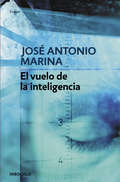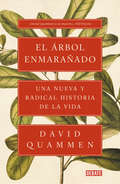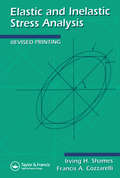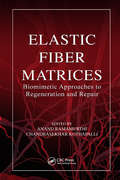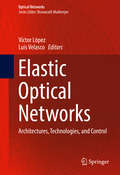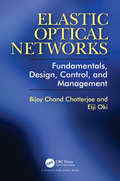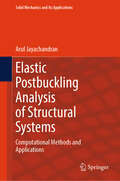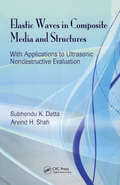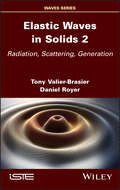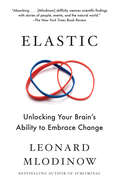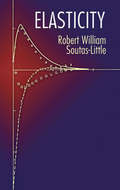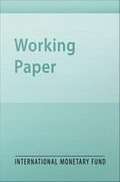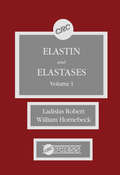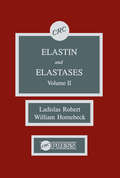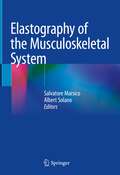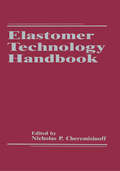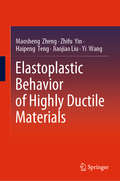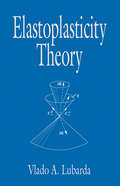- Table View
- List View
El universo informado (A Debate)
by Ervin LaszloEl eminente Dr Ervin Lazslo realiza en esta obra una introdycción no-técnica a los enigmas sin resolver de la ciencia actual. Describe su visión de un universo informado y presenta el "campo-A" como la piedra angular de una nueva teoría científica que se plantea como una auténtica "Teoría Integral del Todo" ue permite resolver las paradojas de la ciencia y otros fenómenos aparentemente inexplicables
El viaje de nuestros genes: Una historia sobre nosotros y nuestros antepasados
by Johannes Krause Thomas Trappe¿QUÉ DICEN NUESTROS GENES SOBRE LA ESPECIE HUMANA? ¿PODEMOS SABER DE DÓNDE VENIMOS? ¿EXISTEN LAS "PERSONAS NATIVAS"? ¿QUÉ ROL JUGÓ LA MIGRACIÓN EN LA EVOLUCIÓN? BESTSELLER DEL DIARIO ALEMÁN DER SPIEGEL El campo de la arqueogenética está experimentando una tremenda revolución científica. Una nueva generación de máquinas de secuenciación de ADN está permitiendo desentrañar los secretos ocultos de nuestros orígenes, y estos descubrimientos están transformando el mapa de la evolución humana. En El viaje de nuestros genes, Johannes Krause, líder indiscutible de esta disciplina, pone a disposición del lector un análisis minucioso de los últimos avances y, con su coautor, el periodista Thomas Trappe, los vincula a los debates políticos actuales en torno a la migración y los reasentamientos masivos, demostrando que están lejos de ser un fenómeno moderno y argumentando que en la sociedad global está la clave hacia el progreso, sobre todo para Europa. Además de responder a una serie de preguntas universales con datos prácticamente irrefutables y relatar desde el descubrimiento de un nuevo eslabón humano hasta el desarrollo de las lenguas indoeuropeas, pasando por la adaptación evolutiva a la lactosa, este libro nos confronta con la dimensión política de la genética. Una perspectiva revolucionaria de la evolución y la historia humana con el objetivo de deconstruir paradigmas y presupuestos arraigados en el imaginario común.
El vuelo de la inteligencia
by José Antonio MarinaJosé Antonio Marina nos introduce en el fascinante camino de la inteligencia para poder utilizar mejor todas sus posibilidades y estimular su desarrollo. Un imprescindible libro de cabecera para todos aquellos que quieran sacar partido de su propia inteligencia: para ello hay que entender qué es y en qué consiste la inteligencia, qué es ser inteligente. <P><P>José Antonio Marina nos toma de la mano y con amor y humor, sabiduría e infinita paciencia nos introduce en el fascinante camino que nos lleva a ese deseo que mueve toda vida: aprender a aprender. Por ello estas páginas hablan de pájaros, pero también del sistema monetario; de poesía, pero también de ciencia y política, del lenguaje y de las imágenes, del poder de la mente y de los sentidos. Y al acabar la lectura nos habremos vuelto un poco más inteligentes; por esta razón éste es un libro lleno de optimismo que alegra, también, el corazón.
El árbol enmarañado: Una nueva y radical historia de la vida
by David QuammenUn revelador libro que abre las puertas a descubrimientos que podrían transformar radicalmente nuestra manera de concebir la evolución. ¿Quiénes somos, qué somos y cómo evolucionó la vida en nuestro planeta? En la década de los setenta diversos científicos empezaron a comparar secuencias de ADN con el fin de ahondar en nuestro conocimiento sobre la historia de la vida. Su trabajo supuso una drástica revisión de uno de los conceptos más básicos de la biología, la idea del árbol de la vida. Al descubrir que los genes también pueden desplazarse lateralmente, traspasando así los límites entre especies, dieron un vuelco a la certeza tradicional de que los genes se transferían de arriba abajo, es decir únicamente de padres a hijos. Una revelación que no solo ponía en duda cuanto sabíamos sobre la evolución humana, sino que inauguraba una serie nueva de incertidumbres, pues acarreaba importantes implicaciones sobre la identidad, la individualidad y la salud humana. En El árbol enmarañado, David Quammen, uno de los mejores divulgadores científicos de la actualidad, nos presenta este y otros hallazgos trascendentales en el campo de la biología molecular para abrirnos las puertas a descubrimientos que transformarán radicalmente nuestra idea de la evolución. Porque, como dice el autor «no somos precisamente lo que pensábamos que éramos. El árbol de la vida está más enmarañado.» Reseñas:«Quammen no es un escritor corriente. Es sorprendente, uno de esos raros narradores bendecidos con brío, ingenuidad, humor, instinto y con un gran corazón.»Elle «Quammen es el mejor reportero del mundo natural. Cada página desborda descripciones de una autenticidad extraordinaria.»Parul Sehgal, The New York Times «David Quammen demuestra ser un guía excepcional, inmensamente bien informado para una historia de tal complejidad. En mi opinión, es el mejor escritor de historia natural; sus libros impresionan por su precisión, su energía y su escritura brillante y evocativa.»David Barash, The Wall Streer Journal «Quammen has escrito una profunda y atrevida aventura intelectual. El árbol enmarañado es mucho más que un reportaje sobre algunos hechos científicos atractivos; es una auténtica fuente de maravillas.»Thomas Levenson, The Boston Globe «Quammen es un maestro en deconstruir conceptos científicos para luego armar con ellos una narrativa coherente, comprensible y reveladora. Es justamente lo que hace en El árbol enmarañado, centrándose en los científicos que, recientemente, han cambiado todo cuanto sabíamos sobre la evolución, la herencia genética y, sí, el origen de las especies.»Jennifer Bort Yacovissi, Washington Independent Review of Books «La ciencia y la filosofía se interconectan de maneras que a la mayoría de nosotros se nos escapan. Pero Quammen siempre está alerta.»John Archibald, Nature «Un vívido testimonio de cómo la nueva investigación genética está cambiando radicalmente la historia de la vida.»Andrea Thompson, Scientific American «Con humor, lucidez y testimonies increíbles de descubrimientos y contiendas, Quammen repasa minuciosamente las revelaciones que han dejado al descubierto la espectacular complejidad de la vida.»Booklist «Una obra maestro de un nuevo campo de la biología molecular [...] un relato impresionante sobre quizás la revolución científica más desconocida del siglo XX.»Kirkus «Quammen es uno de los mejores periodistas científicos y este libro es una obra colosal, una narración maestra sobre cómo el árbol de la vida fue replanteado por un grupo de pensadores originales.»Barbara Kiser, Nature «Quammen explora temas importantesy
Elastic And Inelastic Stress Analysis
by Irving H ShamesPresents certain key aspects of inelastic solid mechanics centered around viscoelasticity, creep, viscoplasticity, and plasticity. It is divided into three parts consisting of the fundamentals of elasticity, useful constitutive laws, and applications to simple structural members, providing extended treatment of basic problems in static structural m
Elastic Fiber Matrices: Biomimetic Approaches to Regeneration and Repair
by Anand Ramamurthi and Chandrasekhar KothapalliElastic Fiber Matrices: Biomimetic Approaches to Regeneration and Repair provides a comprehensive resource on the intrinsic and pathological aberrations of the complex process of elastic matrix assembly and/or variations thereof in different elastic tissue types, and on strategies to regenerate or restore lost elastin matrix, either in vitro or in vivo, including biomimetic elastin-like-peptides, gene therapy, drug delivery, tissue engineering (biomolecules, scaffolds, and mechanical stimuli), pharmacological approaches, elastin stabilization and preservation, stem cell therapy, allografts/xenografts, and synthetic/biological elastomers. Comprised of individual chapters contributed by leading researchers and scientists in the field, the text details current approaches for elastin matrix regeneration and repair, identifying their various advantages and limitations while offering valuable insight into emerging trends. Thus, this book is a must-have guide for academicians and industry professionals working in the areas of connective tissue biology, tissue engineering, dermal and cardiovascular biomaterials, and drug delivery.
Elastic Optical Networks
by Víctor López Luis VelascoThis book presents advances in the field of optical networks - specifically on research and applications in elastic optical networks (EON). The material reflects the authors' extensive research and industrial activities and includes contributions from preeminent researchers and practitioners in optical networking. The authors discuss the new research and applications that address the issue of increased bandwidth demand due to disruptive, high bandwidth applications, e. g. , video and cloud applications. The book also discusses issues with traffic not only increasing but becoming much more dynamic, both in time and direction, and posits immediate, medium, and long-term solutions throughout the text. The book is intended to provide a reference for network architecture and planning, communication systems, and control and management approaches that are expected to steer the evolution of EONs.
Elastic Optical Networks: Fundamentals, Design, Control, and Management
by Eiji Oki Bijoy ChatterjeeThe rapid growth in communications and internet has changed our way of life, and our requirement for communication bandwidth. Optical networks can enable us to meet the continued demands for this bandwidth, although conventional optical networks struggle in achieving this, due to the limitation of the electrical bandwidth barrier. Flexgrid technology is a promising solution for future high-speed network design. To promote an efficient and scalable implementation of elastic optical technology in the telecommunications infrastructure, many challenging issues related to routing and spectrum allocation (RSA), resource utilization, fault management and quality of service provisioning must be addressed. This book reviews the development of elastic optical networks (EONs), and addresses RSA problems with spectrum fragment issues, which degrade the quality of service provisioning. The book starts with a brief introduction to optical fiber transmission system, and then provides an overview of the wavelength division multiplexing (WDM), and WDM optical networks. It discusses the limitations of conventional WDM optical networks, and discusses how EONs overcome these limitations. It presents the architecture of the EONs and its operation principle. To complete the discussion of network architecture, this book focuses on the different node architectures, and compares their performance in terms of scalability and flexibility. It reviews and classifies different RSA approaches, including their pros and cons. It focuses on different aspects related to RSA. The spectrum fragmentation is a serious issue in EONs, which needs to be managed. The book explains the fragmentation problem in EONs, discusses, and analyzes the major conventional spectrum allocation policies in terms of the fragmentation effect in a network. The taxonomies of the fragmentation management approaches are presented along with different node architectures. State-of-the-art fragmentation management approaches are looked at. A useful feature of this book is that it provides mathematical modeling and analyzes theoretical computational complexity for different problems in elastic optical networks. Finally, this book addresses the research challenges and open issues in EONs and provides future directions for future research.
Elastic Postbuckling Analysis of Structural Systems: Computational Methods and Applications (Solid Mechanics and Its Applications #232)
by Arul JayachandranThis book presents a unified computational approach to postbuckling stability analysis of structures using the Total Potential Energy (TPE) framework. It builds upon the secant matrix technique (N1-N2 method) and introduces the Variable Order Secant Matrix (VoSM) method, providing a robust framework for analyzing reticulated, framed, continuum, and thin-walled systems under large deformations. The book derives the geometric nonlinear finite element formulations using Total Lagrangian (TL) and co-rotational TL formats, ensuring accurate postbuckling analysis. It includes benchmark problems and numerical case studies, making it a valuable resource for graduate students, researchers, and faculty involved in structural stability and advanced postbuckling investigations. Additionally, it serves as an indispensable reference for analyzing and designing steel structures.
Elastic Wave Propagation in Structures and Materials
by Srinivasan GopalakrishnanElastic Wave Propagation in Structures and Materials initiates with a brief introduction to wave propagation, different wave equations, integral transforms including fundamentals of Fourier Transform, Wavelet Transform, Laplace Transform and their numerical implementation. Concept of spectral analysis and procedure to compute the wave parameters, wave propagation in 1-D isotropic waveguides, wave dispersion in 2-D waveguides is explained. Wave propagation in different media such as laminated composites, functionally graded structures, granular soils including non-local elasticity models is addressed. The entire book is written in modular form and analysis is performed in frequency domain. Features: Brings out idea of wave dispersion and its utility in the dynamic responses. Introduces concepts as Negative Group Speeds, Einstein’s Causality and escape frequencies using solid mathematical framework. Discusses the propagation of waves in materials such as laminated composites and functionally graded materials. Proposes spectral finite element as analysis tool for wave propagation. Each concept/chapter supported by homework problems and MATLAB/FORTRAN codes. This book aims at Senior Undergraduates and Advanced Graduates in all streams of engineering especially Mechanical and Aerospace Engineering.
Elastic Waves and Metamaterials: The Fundamentals
by Yoon Young KimThis book serves as an introductory text for students and engineers with limited knowledge of metamaterials (and elastic waves). This text begins with the most straightforward vibrating systems, such as single and 2-DOF spring-mass systems. It examines the observed phenomena in 2-DOF systems in an unconventional manner to prepare the reader for research on metamaterials. After presenting wave phenomena in an infinitely connected spring-mass system, an elastic bar, a continuous version of an infinite system, is analyzed. This instructional strategy, which progresses from the discrete model to the continuous model, facilitates efficient comprehension of wave and metamaterial concepts. Using continuous and discrete one-dimensional models, bending waves and their manipulation through metamaterials are also discussed. In the latter chapters of this book, advanced readers are introduced to the fundamental wave phenomena in two-dimensional media and wave manipulation using metamaterials, such as mode-converting transmission. As wave phenomena are the fundamental phenomena in vibrating structures, those interested in acoustics and vibration would gain a great deal of knowledge from this book, as the material covered in it offers a very different perspective on oscillatory phenomena than what is typically found in books on acoustics and vibration. Because this book presents a new technique for manipulating waves using metamaterials, engineers and scientists who work with (ultra)sounds and structural vibrations would find it very useful for expanding their knowledge of relevant topics.
Elastic Waves in Composite Media and Structures: With Applications to Ultrasonic Nondestructive Evaluation (Mechanical and Aerospace Engineering Series)
by Subhendu K. DattaNew applications for composite materials are being developed at a rapid pace. However, their complex microstructures present considerable challenges for nondestructive testing and characterization. Ultrasonic waves provide quantitative means of nondestructive evaluation of these materials and structures. For this purpose, it is necessary to obtain
Elastic Waves in Solids 1: Propagation
by Daniel Royer Tony Valier-BrasierElastic waves are used in fields as diverse as the non-destructive evaluation of materials, medicine, seismology and telecommunications. Elastic Waves in Solids 1 presents the different modes of propagation of elastic waves in increasingly complex media and structures. It first studies the propagation in an unlimited solid where only the material properties are taken into account. It then analyzes reflection and transmission phenomena at an interface with a fluid or a second solid.It explains the search for propagation modes on a free surface or at the interface between two media. Finally, it proposes a study of the dispersive propagation of elastic waves guided by a plate or a cylinder. This book is intended for students completing a master’s degree in acoustics, mechanics, geophysics or engineering, as well as teachers and researchers in these disciplines.
Elastic Waves in Solids, Volume 2: Radiation, Scattering, Generation
by Daniel Royer Tony Valier-BrasierElastic waves are used in fields as diverse as the non-destructive evaluation of materials, medicine, seismology and telecommunications. Elastic Waves in Solids 2 analyzes the radiation, scattering and generation of these waves. It studies the emission of bulk or surface waves from sources localized on the surface of an isotropic or anisotropic solid. It then examines the scattering of a longitudinal or transverse elastic wave by one or more cylindrical or spherical heterogeneities. Finally, it explores the methods and devices used to generate and detect elastic waves, using the piezoelectric effect or the interaction with a laser beam. Accompanying figures illustrate these properties, and the text provides the orders of magnitude of some characteristic parameters. This book is intended for students completing a master&’s degree in acoustics, mechanics, geophysics or engineering, as well as teachers and researchers in these disciplines.
Elastic: Flexible Thinking in a Time of Change
by Leonard MlodinowFrom the best-selling author of Subliminal and The Drunkard’s Walk comes a groundbreaking look at the psychology and neuroscience of change, and at how tapping into elastic thinking will help us thrive in the modern world. <P><P>Drawing on cutting-edge research, Leonard Mlodinow takes us on an illuminating journey through the mechanics of our minds as we navigate the rapidly changing landscapes around us. <P><P>Out of the exploratory instincts that allowed our ancestors to prosper hundreds of thousands of years ago, humans developed a cognitive style that Mlodinow terms elastic thinking, a unique set of talents that include neophilia (an affinity for novelty), schizotypy (a tendency toward unusual perception), imagination and idea generation, and divergent and integrative thinking. <P><P>These are the qualities that enabled innovators from Mary Shelley to Miles Davis, from the inventor of jumbo-sized popcorn to the creators of Pokémon Go, to effect paradigm shifts in our culture and society. <P><P>In our age of unprecedented technological innovation and social change, it is more important than ever to encourage these abilities and traits.How can we train our brains to be more comfortable when confronting change and more adept at innovation? How do our brains generate new ideas, and how can we nurture that process? Why can diversity and even discord be beneficial to our thought process? <P>With his keen acumen and quick wit, Leonard Mlodinow gives us the essential tools to harness the power of elastic thinking in an endlessly dynamic world.
Elasticity (Dover Books on Physics)
by Robert William Soutas-LittleAccording to the author, elasticity may be viewed in many ways. For some, it is a dusty, classical subject . . . to others it is the paradise of mathematics." But, he concludes, the subject of elasticity is really "an entity itself," a unified subject deserving comprehensive treatment. He gives elasticity that full treatment in this valuable and instructive text. In his preface, Soutas-Little offers a brief survey of the development of the theory of elasticity, the major mathematical formulation of which was developed in the 19th century after the first concept was proposed by Robert Hooke in 1678. The theory was further refined in the 20th century as a means of solving the equations presented earlier.The book is divided into three major sections. The first section presents a review of mathematical notation and continuum mechanics, covering vectors and tensors, kinematics, stress, basic equations of continuum mechanics, and linear elasticity. The second section, on two-dimensional elasticity, treats the general theory of plane elasticity, problems in Cartesian coordinates, problems in polar coordinates, complex variable solutions, finite difference and finite element methods, and energy theorems and variational techniques. Section three discusses three-dimensional problems, and is devoted to Saint Venant torsion and bending theory, the Navier equation and the Galerkin vector, and the Papkovich-Neuber solution.Numerous illustrative figures and tables appear throughout the book, and valuable reference material is provided in the appendices on eigenfunction analysis, trigonometric functions, Fourier transforms, inverse transforms, complex variable formulae, Hankel transforms, and Bessel and Legendre functions.Instructors will find this an ideal text for a two-course sequence in elasticity; they can also use it as a basic introduction to the subject by selecting appropriate sections of each part.
Elasticity for Geotechnicians
by Paolo Podio-Guidugli Antonino FavataThis book deals in a modern manner with a family of named problems from an old and mature subject, classical elasticity. These problems are formulated over either a half or the whole of a linearly elastic and isotropic two- or three-dimensional space, subject to loads concentrated at points or lines. The discussion of each problem begins with a careful examination of the prevailing symmetries, and proceeds with inverting the canonical order, in that it moves from a search for balanced stress fields to the associated strain and displacement fields. The book, although slim, is fairly well self-contained; the only prerequisite is a reasonable familiarity with linear algebra (in particular, manipulation of vectors and tensors) and with the usual differential operators of mathematical physics (gradient, divergence, curl, and Laplacian); the few nonstandard notions are introduced with care. Support material for all parts of the book is found in the final Appendix.
Elasticity in Engineering Mechanics
by Arthur P. Boresi Kenneth P. ChongElasticity in Engineering Mechanics has been prized by many aspiring and practicing engineers as an easy-to-navigate guide to an area of engineering science that is fundamental to aeronautical, civil, and mechanical engineering, and to other branches of engineering. With its focus not only on elasticity theory, including nano- and biomechanics, but also on concrete applications in real engineering situations, this acclaimed work is a core text in a spectrum of courses at both the undergraduate and graduate levels, and a superior reference for engineering professionals.
Elastin and Elastases, Volume I
by Ladislas Robert William HornebeckWritten by internationally known European and American scientists, these volumes systematically present many topics in the elastin and elastases fields. Volume I explains elastin, its biosynthesis, physicochemical properties, and alteration in a variety of pathologies and with aging. Volume II describes elastases, their physiological and pathological roles and their control by natural and synthetic inhibitors. Filled with illustrations and figures, these volumes will benefit researchers, physicians, and industrial scientists.
Elastin and Elastases, Volume II
by Ladislas Robert William HornebeckWritten by internationally known European and American scientists, these volumes systematically present many topics in the elastin and elastases fields. Volume I explains elastin, its biosynthesis, physicochemical properties, and alteration in a variety of pathologies and with aging. Volume II describes elastases, their physiological and pathological roles and their control by natural and synthetic inhibitors. Filled with illustrations and figures, these volumes will benefit researchers, physicians, and industrial scientists.
Elastography of the Musculoskeletal System
by Salvatore Marsico Albert SolanoIn this book recognized world-renowned expert authors expose the state of the art on musculoskeletal ultrasound elastography.Low cost, wide dissemination and accuracy in the evaluation of the musculoskeletal structures, nerves, periosseous soft parts, vascular structures, together with the possibility of performing real time dynamic studies, made the ultrasound technique widely spread among sonographers and musculoskeletal radiologists.Each chapter presents a description of the elastographic semiotics of the main pathologies of the musculoskeletal system and soft tissue, images that represent both routine and more complex clinical cases in a practical and schematic way and summary tables on the characteristics in terms of elasticity found in the main pathologies.A wealth of color images as well as dynamic images and tables complete the book, that will be a useful tool for sonographers , radiologists, orthopedists, sports medicine specialists wishing to expand their knowledge on ultrasound elastography.
Elastomer Technology Handbook
by Nicholas P. Cheremisinoff Paul N. CheremisinoffElastomer Technology Handbook is a major new reference on the science and technology of engineered elastomers. This contributed volume features some of the latest work by international experts in polymer science and rubber technology. Topics covered include theoretical and practical information on characterizing rubbers, designing engineering elastomers for consumer and engineering applications, properties testing, chemical and physical property characterization, polymerization chemistry, rubber processing and fabrication methods, and rheological characterization. The book also highlights both conventional and emerging market applications for synthetic rubber products and emphasizes the latest technology advancements. Elastomer Technology Handbook is a "must have" book for polymer researchers and engineers. It will also benefit anyone involved in the handling, manufacturing, processing, and designing of synthetic rubbers.
Elastoplastic Behavior of Highly Ductile Materials
by Yi Wang Maosheng Zheng Zhifu Yin Haipeng Teng Jiaojiao LiuThis book mainly introduces some basic phenomena and laws of highly ductile materials during elastoplastic deformation, and their engineering applications, such as the transfer and relief of stress concentration in the notch root, the mitigation of possible brittle fracture, the ductile deformation and damage, fatigue, energy absorption, plastic buckling, thermal stress problems, etc. It shows a number of revolutions in modern applications and design, which are beneficial to the safety of modern equipment, and improve applicability. In addition, the first three chapters of this book also briefly introduce the basic knowledge of elastoplastic deformation and analysis as a preliminary knowledge. This book can be used as a textbook for advanced undergraduate students and postgraduate in non-mechanics majors such as mechanical engineering, power, material or civil engineering, as well as scholars and engineers in related fields.
Elastoplasticity Theory
by Vlado A. LubardaUnderstanding the elastoplastic deformation of metals and geomaterials, including the constitutive description of the materials and analysis of structure undergoing plastic deformation, is an essential part of the background required by mechanical, civil, and geotechnical engineers as well as materials scientists. However, most books address the su


